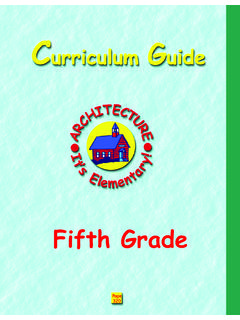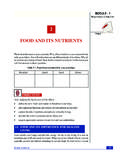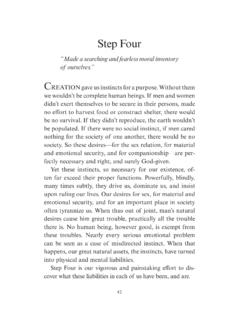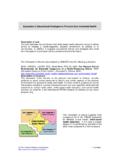Transcription of Second Grade - k5Architecture Home
1 Second GradePage139 Second GradePage1412 GradeLesson1 Second Grade Lesson OneSECOND GRADELESSON NO. 1 ANIMAL HOUSESLENGTH OF LESSON: 30 - 60 MINUTESARCHITECTURAL PRINCIPLES: Form follows function is a design approach where the form of the building is determined by the function of its spaces and its parts. Nature is a model for architectural forms and shapes. social structure, culture and the built environment have a direct influence on one another. Climate and the natural environment influence design Animal homes - actual examples or photographs on 8-1/2 X 11-inch paper (some sample photographs are included)2. Crayons, colored pencils, paint, etc. (teacher s choice)3. Scissors4. GlueVOCABULARY (See glossary for definitions)1. Safety2. ShelterSecond Grade Lesson OnePage1422 GradeLesson1 ACTIVITYA. Begin by having students suggest a list of animals and the type of homes they build or occupy.
2 Write the list of student suggestions on the board. Where pos-sible, staff and students can bring in actual examples: a bird s nest, a hornet s nest, a honeycomb, sea coral or a spider web. A sample of various animal homes is included for teacher s Discuss each animal and its home . Specifically discuss how each home addresses such issues as safety, protection from elements and food gathering, and how each home is constructed. Emphasize how each animal uses only natural materi-als found nearby. When an animal abandons his home it may be used by another creature, or it returns to nature. Examples may include animal-constructed homes, caves, trees, holes in the ground and man-made animal homes, such as a doghouse or a Discuss with students how each type of home relates to the animal s specific social structure. Does the animal live alone, in a family, or in a community?
3 If in a community, are there different roles each animal plays within that commu-nity? Examples include the division of labor in an anthill, the role of food gath-erer, or lookout in a prairie dog colony, Ask students how they would describe the social structure of a family. How would they describe the social structure of a community? Do people live alone or with families? Do people have different roles within their family?E. Have students choose an animal and draw or paint the animal and its home . These are to be included in the mural project in Lesson No. 10. Note: Decide on the size of the mural before students create their artwork. Their animals/homes need to be in proper proportion to the size of the final mural. Lesson No. 9 suggests the mural be 4 feet in height by 8 feet in S EVALUATIONA. Analyze student artwork for:1. Accuracy according to the discussion and examples2.
4 Careful execution and neatnessFIRST GRADE2 GradeLesson1 Second Grade Lesson OnePage143 Beaver DamBeehiveBird s NestTermite TowerSecond Grade Lesson TwoPage1442 GradeLesson2 Second GRADELESSON NO. 2 MAN-MADE STRUCTURESLENGTH OF LESSON: 30 - 60 MINUTESARCHITECTURAL PRINCIPLES: Form Follows Function is a design approach where the form of the building isdetermined by the function of its spaces and its is a model for architectural forms and and the natural environment influence design understanding of the natural environment can help to save energy and waterSocial structure, culture and the built environment have a direct influence onone satisfies emotional and spiritual needs in addition to physical , current, and future technologies influence design Visual aids: Homes Are Different and Roles People Play charts (included); make a copy for each student or use transparency with overhead projector2.
5 8-1/2 X 11-inch paper3. Crayons, colored pencils, paint, etc. (teacher s choice)4. Scissors5. Graph paper ( -inch grid); students will draw buildings on the back side of the graph paper (the grid should be dark enough to see through the paper) Page1452 GradeLesson2 Second Grade Lesson TwoVOCABULARY (See glossary for definitions)1. Community2. Home3. Natural EnvironmentACTIVITYA. Display the Homes Are Different chart handout (provided). Teacher may choose to create an overlay of the chart and use an overhead projector for display. Continue discussion of animal homes; talk about the similarities to how people build homes. Also, discuss the various types of homes people live in, such as houses, apartments, mobile homes, houseboats and While referencing the Homes Are Different handout, discuss how people s homes have changed historically. Refer to prehistoric man and caves, knights and castles, Native Americans and teepees, and Southwest Native Americans and cliff dwellings.
6 How did each group respond to the time and place in which it lived? Talk about such things as protection from the elements, safety, building materials available, and social Discuss with students how people s houses differ geographically in response to different environments and building materials available. Examples could in-clude Eskimos and igloos, African tribes and grass huts, desert dwellers and tents, etc. Discuss how these groups of people utilized the natural environment. Discuss how the direction of the sun or wind might affect the way the house should face. Discuss how the amount of rain, snow or sun might affect how the house is Grade Lesson TwoPage1462 GradeLesson2D. Display the Roles People Play chart. Remind students of the discussion about animals that live in communities and the social structure, or division of labor, inherent in each community.
7 Have students discuss the roles people have in families and communities. Develop a list of roles people play in a community and the buildings needed to house each of these functions: Fire station Police ..Police station Teacher ..School Librarian ..Library Mayor ..City Hall Doctor/nurse ..Hospital and medical offices Other examples: clerk and store, baker and bakery, mechanic and garage, Ask students to draw a building from the Roles People Play chart created in Step E. A one-story building should be 4-inches (or 8 squares); a two story building 8-inches (or 16 squares). These will be included in the mural project in Lesson No. 10. Ask students to consider how the natural environment may be considered in their S EVALUATIONA. Analyze student art work for:1. Accuracy according to the discussion and examples;2. Careful execution and Use of natural materials and consideration of the natural environment.
8 FIRST GRADE2 GradeLesson2 Second Grade Lesson TwoPage147 Roles People PlayIN A COMMUNITY .. ROLES PEOPLE PLAY ROLE BUILDINGFIRE FIGHTER POLICETEACHER LIBRARIANMAYOR DOCTOR/NURSE CLERKBAKER Second Grade Lesson Two2 GradeLesson2 Page148 Homes Are DwellersLog CabinIgloo for EskimosAfrican TribesDesert DwellersStilt HousesHousesApartmentMobile Other PlacesSecond Grade Lesson ThreePage1502 GradeLesson3 Second GRADELESSON NO. 3 STRUCTURAL CONCEPTSLENGTH OF LESSON: 30 - 60 MINUTESARCHITECTURAL PRINCIPLES: Nature is a model for architectural forms and shapes. Sustainable design of the built environment protects the natural environment. Order is the arrangement and organization of elements to help solve visual and functional problems.
9 Form follows function is a design approach where the form of the building is determined by the function of its spaces and its parts. Past, current and future technologies influence design Sketches of structures arches (aqueducts), Greek columns, beam, suspen-sion bridge, dome and cross-section of a dome2. Copies for each student of photographs of different structural types (included) from Kindergarten Lesson No. 5 Acting Out Structures 3. Wood blocks and books4. String5. Bowl6. Pencils or crayonsVOCABULARY (See glossary for definitions)1. Aqueduct 4. Column 7. Gravity 2. Arch 5. Compression 8. Structure3. Beam 6. Dome 9. TensionPage1512 GradeLesson3 Second Grade Lesson ThreeACTIVITYA. Review the concept of structure. The teacher rests his/her elbow on the desktop with forearm up and hand out flat, palm up, to hold up a book. Ask why the book doesn t fall to the ground.
10 Discuss the pull of gravity. Explain that the teacher s forearm is an example of a column, and the book is a beam. What holds these things in place? Show how the weight of the book is transferred to the ground (desktop) through the column (forearm).B. Review elements of Kindergarten Lesson No. 5: Acting Out Structures. Using models, wood blocks or books, demonstrate a column and beam structure. Ex-plain how the weight is transferred through the columns. Explain how the col-umns are in compression. Show pictures of Greek temples and ask students to identify the column and beam structures, and what elements of the building are in Using a block and string, demonstrate tension. Tie a string on both ends of the beam (block of wood). Hold the end of each piece of string and suspend the block of wood down from the string on each end. Have students identify what is holding up the beam and how the weight is transferred.






